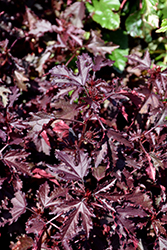Height: 4 feet
Spread: 6 feet
Sunlight:
![]()
![]()
Hardiness Zone: (annual)
Other Names: African Rosemallow, Maroon Mallow
Description:
This striking, tender perennial sub-shrub features lobed, deep burgundy foliage similar to Japanese maple; small deep burgundy flowers in late fall through winter; ideal for the mixed garden border or containers
Ornamental Features
Cranberry Hibiscus's attractive glossy lobed leaves emerge dark red in spring, turning burgundy in color throughout the season on a plant with an upright spreading habit of growth. It features subtle dark red round flowers with black eyes at the ends of the stems from early fall to mid winter. The dark red stems are very colorful and add to the overall interest of the plant.
Landscape Attributes
Cranberry Hibiscus is an herbaceous annual with an upright spreading habit of growth. Its relatively coarse texture can be used to stand it apart from other garden plants with finer foliage.
This plant will require occasional maintenance and upkeep, and is best cleaned up in early spring before it resumes active growth for the season. It is a good choice for attracting bees, butterflies and hummingbirds to your yard. Gardeners should be aware of the following characteristic(s) that may warrant special consideration;
- Insects
- Self-Seeding
Cranberry Hibiscus is recommended for the following landscape applications;
- Accent
- Mass Planting
- General Garden Use
- Naturalizing And Woodland Gardens
- Container Planting
Planting & Growing
Cranberry Hibiscus will grow to be about 4 feet tall at maturity, with a spread of 6 feet. Although it's not a true annual, this fast-growing plant can be expected to behave as an annual in our climate if left outdoors over the winter, usually needing replacement the following year. As such, gardeners should take into consideration that it will perform differently than it would in its native habitat.
This plant does best in full sun to partial shade. It prefers to grow in average to moist conditions, and shouldn't be allowed to dry out. This plant should not require much in the way of fertilizing once established, although it may appreciate a shot of general-purpose fertilizer from time to time early in the growing season. It is not particular as to soil pH, but grows best in rich soils. It is highly tolerant of urban pollution and will even thrive in inner city environments, and will benefit from being planted in a relatively sheltered location. Consider applying a thick mulch around the root zone in winter to protect it in exposed locations or colder microclimates. This species is not originally from North America..
Cranberry Hibiscus is a fine choice for the garden, but it is also a good selection for planting in outdoor pots and containers. With its upright habit of growth, it is best suited for use as a 'thriller' in the 'spiller-thriller-filler' container combination; plant it near the center of the pot, surrounded by smaller plants and those that spill over the edges. It is even sizeable enough that it can be grown alone in a suitable container. Note that when growing plants in outdoor containers and baskets, they may require more frequent waterings than they would in the yard or garden.

